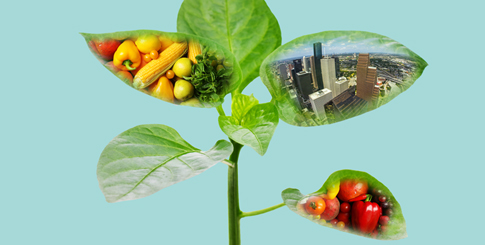
On or Off the Market
Whether they’re at the Center or not, most local produce companies agree there are numerous advantages to being in Houston. Location is frequently trumpeted as one of the biggest perks. Steve Bramel, president of Bramel Trucking, has been part of the Houston Produce Center since its opening in 1954 and touts the convenience of being near the Rio Grande Valley and its border crossings, as well as easier access to customers in the Midwest and the East Coast. He also believes the Port of Houston has an important role to play in the not-too-distant future. “The Port is getting ready to grow,” he notes, “I think we’ll see container ships with produce coming in.”
Jimmy Ramos, manager of Ramos Produce, Inc., says the area’s geographic location is a huge plus. “Texas is so big that I can ship to Austin, San Antonio, Dallas, pretty much anywhere, and in Houston, we’re in the middle,” he says. “We’re also only a five-hour drive to The Valley, so it’s easy for us to get product overnight.”
Houston Produce Center
Opened in 1954 as a distribution hub with easy access to rail and highways.
Address & Phone:
3144 Produce Row
Houston, TX 77023
713-928-2481
Manager:
Larry Biondillo
For Integrity Distribution Services, LLC’s Rudy Armendariz, the upside of doing business in the Bayou City is its sheer size. While much of the country suffered during the recent recession, Houston weathered it well and has bounced back even better. “Things have slowed down a bit with the oil slump, but we’re still a food town and we like to eat out,” says Armendariz, whose focus is on citrus, melons, and potatoes. “With all the people coming here, the volume keeps growing.”
Bramel, too, commented on the oil bust and the proliferation of workers looking for jobs. “Quite a few people who drove in the oilfield are now coming back and looking for trucking jobs,” he observes. The upside of the drop in oil prices, of course, has been the simultaneous drop in fuel prices. “Lower fuel prices have been very good for us,” he shares. “Drivers have finally been able to catch their breath a little.”
The Effects of Weather
With every advantage comes a challenge, and the produce industry in greater Houston has faced its share on the path to success. Among the biggest is weather, which always plays a critical role in quality and availability whether in Texas, California, Arizona, or Mexico. A stark reminder of Mother Nature’s power came in April and May when much of Texas was blanketed with torrential rain, causing flooding. Houston and South-eastern Texas were particularly hard hit.
From its founding in 1836 to today, things have changed immensely in Houston. These days, it is the fourth-largest city in the United States, with a population of 2.1 million within city limits and 6.6 million in the greater metropolitan area. It is also a key produce hub just hours from growers and importers in the Rio Grande Valley region.
What’s more, for a city known for its skyscrapers and busy multilane highways, the Office of Sustainability—which oversees a range of green projects—makes sure Houstonians have easy access to fresh fruits and vegetables from dozens of farmers’ markets (City Hall even has its own), while the Grocery Access Task Force brings affordable, healthy food retailers into underserved communities throughout the city and state.
Changing Market
One place that has been around to witness much of the city’s rapid growth and evolution is the Houston Produce Center, a 56-acre terminal market that serves the city and surrounding suburbs.
Like many markets in large metropolitan areas, one of the Center’s greatest assets is its location, south of downtown. “We’re close to all the freeways and main thoroughfares,” says Larry Biondillo, manager and a 30-year veteran of the market. “Tenants can get trucks out of here at four a.m., get on the freeway, and get to their first location without being stuck in traffic. It’s also central for getting trucks in from across the country.”
Over the last several years, the Center has been modernizing operations, with upgrades in paneling, refrigeration systems, doors, and dock levelers. There have also been challenges with security, safety, and parking. Most tenants have their own trucks and on any given day, there may be 500 trucks loading and unloading, driving in and out. “It’s a constant battle keeping parking lots up with so many trucks coming in and out,” Biondillo concedes.
Changing Demand
Staying ahead of the curve is something the wholesalers at the Houston Produce Center know a bit about. Brothers Produce was founded in 1979 with just one van, and now the family business occupies 160,000 square feet at the Center with plans for more. The company also has facilities in Dallas and Austin. Brent Erenwert, president, says the majority of Brothers’ customers are in foodservice, including hotels, restaurants, and clubs. The supplier has also seen a marked increase in demand for organics too.
José Bueno, vice president of Lone Star Fruit & Vegetable, has been a presence on the market for 30 years and commented on the evolving product mix, especially the Hispanic emphasis with demand for chilies, avocados, and cilantro growing at a record pace.
Bella Fresh Houston LLC’s general manager, Preston Fletcher, agrees, also pointing out the rising popularity of Asian specialties over the last five or so years. As a regional fresh fruit and vegetable processor with headquarters in Arizona, Bella Fresh can source and ship to customers on either coast with ease. Thanks to the new highway that has cut driving time from Mexico’s western coast to Pharr, Texas by several hours, it’s easier than ever to get a load of produce delivered quickly.
On or Off the Market
Whether they’re at the Center or not, most local produce companies agree there are numerous advantages to being in Houston. Location is frequently trumpeted as one of the biggest perks. Steve Bramel, president of Bramel Trucking, has been part of the Houston Produce Center since its opening in 1954 and touts the convenience of being near the Rio Grande Valley and its border crossings, as well as easier access to customers in the Midwest and the East Coast. He also believes the Port of Houston has an important role to play in the not-too-distant future. “The Port is getting ready to grow,” he notes, “I think we’ll see container ships with produce coming in.”
Jimmy Ramos, manager of Ramos Produce, Inc., says the area’s geographic location is a huge plus. “Texas is so big that I can ship to Austin, San Antonio, Dallas, pretty much anywhere, and in Houston, we’re in the middle,” he says. “We’re also only a five-hour drive to The Valley, so it’s easy for us to get product overnight.”
Houston Produce Center
Opened in 1954 as a distribution hub with easy access to rail and highways.
Address & Phone:
3144 Produce Row
Houston, TX 77023
713-928-2481
Manager:
Larry Biondillo
For Integrity Distribution Services, LLC’s Rudy Armendariz, the upside of doing business in the Bayou City is its sheer size. While much of the country suffered during the recent recession, Houston weathered it well and has bounced back even better. “Things have slowed down a bit with the oil slump, but we’re still a food town and we like to eat out,” says Armendariz, whose focus is on citrus, melons, and potatoes. “With all the people coming here, the volume keeps growing.”
Bramel, too, commented on the oil bust and the proliferation of workers looking for jobs. “Quite a few people who drove in the oilfield are now coming back and looking for trucking jobs,” he observes. The upside of the drop in oil prices, of course, has been the simultaneous drop in fuel prices. “Lower fuel prices have been very good for us,” he shares. “Drivers have finally been able to catch their breath a little.”
The Effects of Weather
With every advantage comes a challenge, and the produce industry in greater Houston has faced its share on the path to success. Among the biggest is weather, which always plays a critical role in quality and availability whether in Texas, California, Arizona, or Mexico. A stark reminder of Mother Nature’s power came in April and May when much of Texas was blanketed with torrential rain, causing flooding. Houston and South-eastern Texas were particularly hard hit.
Before the devastating floods, there were cooler than usual temperatures in parts of the state, affecting everything from watermelon and grapefruit to strawberries and oranges. At Ramos Produce, the chilly weather meant demand for watermelons was low and planting was delayed.
“The level of crop availability has been variable,” says Fletcher, “if you’re only getting a percentage of what you would normally buy, then you have to buy on the open market and that has a financial impact.” Despite purchasing product from California, Arizona, Idaho, and Washington state, he says, “El Niño has done wonders for the water table, but it affected plantings.” And less product means costs go up, even if the quality isn’t quite top-notch.
On the other hand, a bumper crop—due to flawless weather in some growing areas—can mean problems of a different type. “Good weather is kind of a handcuff,” acknowledges Scott Blanchard, head of Latin grower relations at Tomato Management Corp. When there’s too much supply, he notes, the resulting glut of product can also affect both quality and price.
There are solutions to variable supply: contracts. Erenwert says Brothers Produce has secured more grower-direct contracts, due to weather and market volatility. “With our volume, getting rid of the middleman here and there adds up. We’re cutting more contracts at the growing level and basically investing in the dirt. This allows us to compete in the market more effectively and without product shortages.”
For brokers like Armendariz, storms on Mexico’s west coast did affect his suppliers to an extent. “It has been a down year, compared to past years,” he admits, noting that the volume coming out of Arizona hasn’t kicked off as expected. “Normally, we struggle to find trucks to load our product, but we’ve had independents calling us. That means there’s not enough product.”
Other Hazards & Headaches
Weather isn’t the only headache. As potential hazards, pests and diseases are often waiting in the wings. Fletcher isn’t as concerned about “normal” pests like epidural peel or whitefly. Instead, his concern is for pathogens like salmonella or listeria, which are a bigger worry for processors. “We’re more susceptible and have to go through extra steps to clean the product and keep the cold chain intact,” he says.
Food safety continues to loom large across the industry. “We talk about it a lot and do everything we can possibly do,” Fletcher says. “Look at what happened with Chipotle—there’s always a risk.”
Concern and awareness have reached such levels that Armendariz has started asking his growers and shippers to show him their food safety audits. His own customers have tightened food safety protocols and, in turn, are asking about it. “The melon and lettuce outbreaks a few years ago really got people’s attention,” he notes. “So they’re requesting our documents. They want to be sure the food is safe.”
Ramos Produce requires all of its growers and shippers to have third-party certification. “In the last three years, the major chain stores won’t buy from you unless you can show certification or traceability,” Ramos says. “It’s really the new normal.”
Final Thoughts
If the boom of recent years is any indication, Houston’s produce industry can look forward to continued growth and a terminal market ripe with opportunity. “We’re 99 percent occupied now,” Biondillo says. “Whether we’ll be able to accommodate expanding tenants, I don’t know. We have to stay ahead of companies that are growing.”
Images: Africa Studio/DenisNata/Jorg Hackemann/Shutterstock.com



